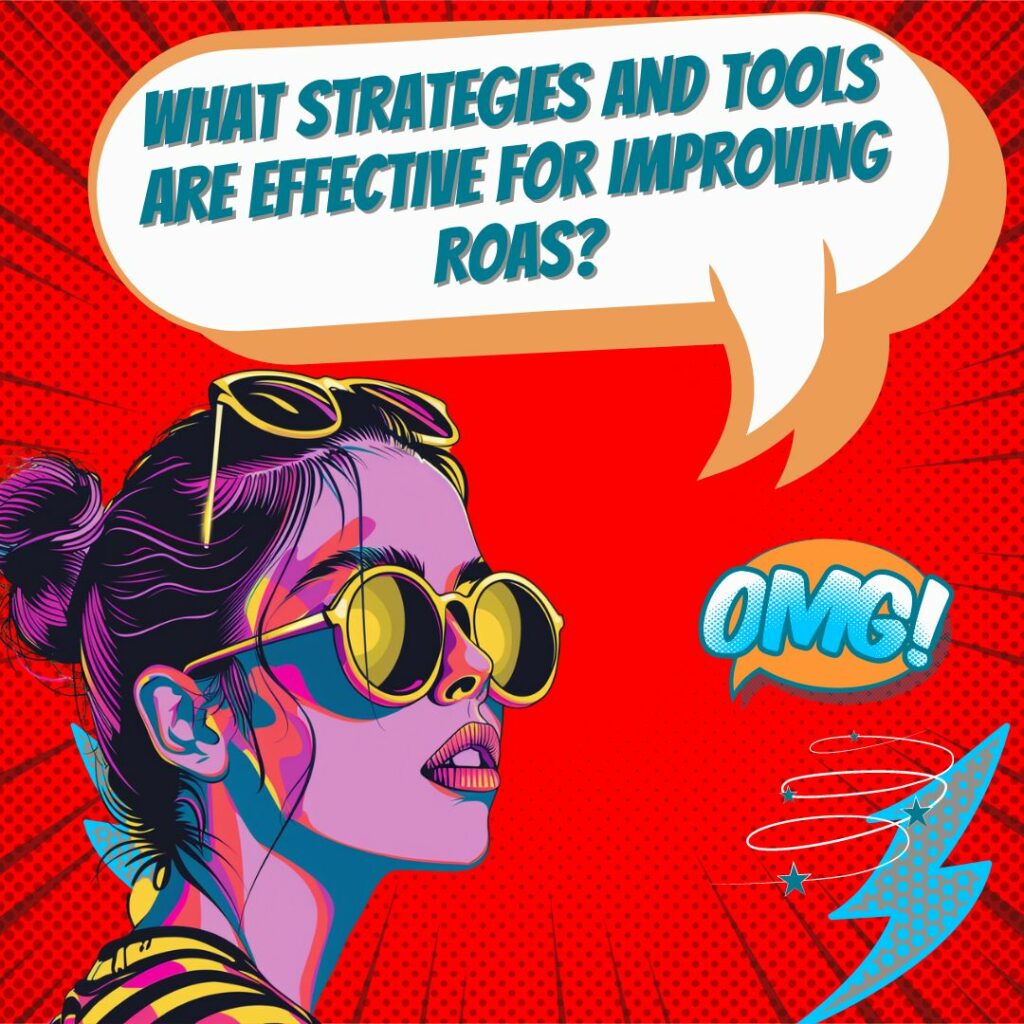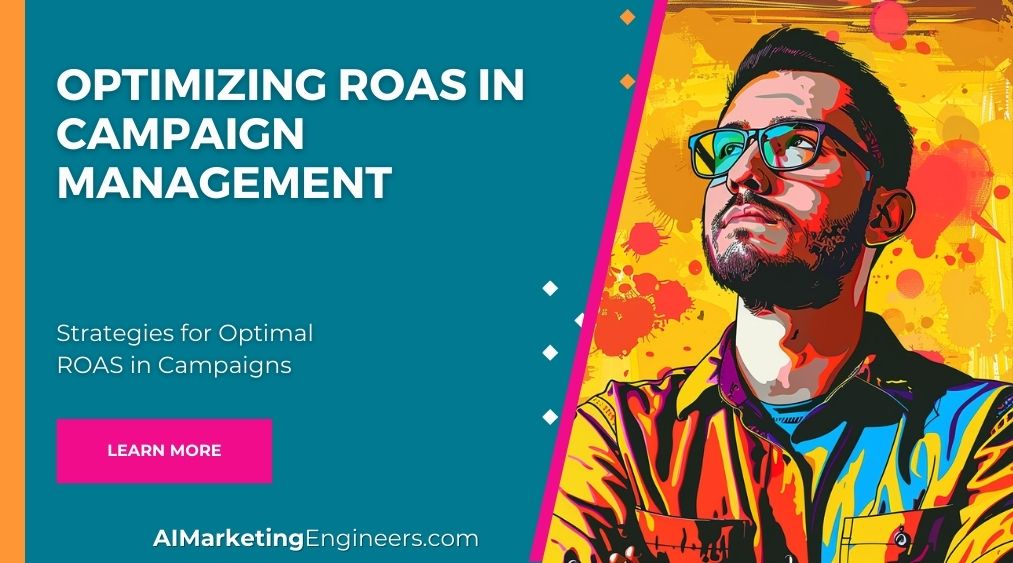Key Takeaways
✅ Audience Precision: Sharpen your targeting approach by slicing through the market with laser-focused audience segmentation, ensuring your ads resonate with the most receptive demographics.
✅ Iterative Excellence: Cultivate a culture of continuous improvement with relentless A/B testing, harnessing the power of data to fine-tune your campaigns for peak performance.
✅ Strategic Bidding: Adopt cutting-edge automated bidding strategies like target ROAS to maintain the balance between expenditure and outcomes, tailoring your bids to the heartbeat of campaign success.

Introduction
Are you maximizing the effectiveness of every ad dollar spent? Optimizing Return On Advertising Spend (ROAS) is not just a metric, it’s a mark of mastery in campaign management. In the swiftly evolving digital marketing landscape, understanding ROAS is crucial for gauging and enhancing the impact of your advertising efforts.
Imagine consistently delivering campaigns that not only meet but exceed your profit expectations. This article brings the forefront of innovation and the most effective modern strategies that will redefine how you approach ROAS. From identifying realistic ROAS goals based on your brand’s historical data to leveraging the latest in automation for bidding strategies, we will journey through the avenues of precision targeting and continuous optimization to elevate your campaigns to new heights.
Enthralled by the potential to enhance your marketing results? Stay with us as we unfold actionable insights and trailblazing knowledge that will catapult your advertising efforts into a new realm of efficiency and success. Unearth the secrets within, and let’s embark on this transformative expedition to rocket your ROAS.
Top Statistics
| Statistic | Insight |
|---|---|
| Mobile Ad Spend Share: Projected to hold a 64.7% share in 2021. (Source: eMarketer) | The domination of mobile in digital advertising underscores the need to optimize campaigns for mobile devices to ensure high ROAS. |
| Social Media Ad Spend Growth: Increased nearly 20% in 2020, reaching $98.4 billion. (Source: eMarketer) | Engagement and targeting precision make social media platforms powerful vehicles for ROAS optimization. |
| Retargeting ROAS: Average ROAS of 1,470%. (Source: Criteo) | Retargeting remains one of the most effective strategies, transforming potentially lost conversions into valuable sales. |
| Personalization Impact: 80% more likely to make a purchase when offered personalized experiences. (Source: Epsilon) | Personalization is key to elevating customer engagement and boosting campaign ROAS. |
| AI and Automation Adoption: 67% of marketing leaders are leveraging AI. (Source: Salesforce) | The embrace of AI and automation signifies a shift towards more efficient and sophisticated ROAS optimization. |
Understand Your Audience Inside and Out
The foundation of any successful marketing campaign is a deep understanding of your target audience. Start by conducting detailed research to paint a crystal-clear picture of who your customers are - their demographics, interests, online behaviors, pain points, and purchase drivers. This intel will be gold when it comes to crafting compelling ad creative and zeroing in on the right channels and targeting tactics.
Once you have a handle on your audience, get to work segmenting them into meaningful groups. Think about slicing and dicing by factors like age, location, income level, browsing history, or even psychographic traits. Then use these audience segments to inform hyper-personalized campaigns that speak directly to each group's unique needs and motivations.
Optimize Your Ad Placements and Targeting
With your audience insights in hand, it's time to identify the advertising channels and targeting strategies that will deliver the biggest ROAS bang for your buck. Social media, search, display - test out the options and see where you get the most engagement and conversions. Don't be afraid to experiment with data-driven tactics like behavioral, contextual, and lookalike targeting as well.
The key is to continuously test and refine your approach. Monitor performance metrics like click-through rates, conversion rates, and cost-per-acquisition to see what's working (and what's not). Then make the necessary tweaks to optimize your campaigns for maximum ROAS.
Craft Compelling Ads that Resonate
Driving a high ROAS isn't just about finding the right audiences and ad placements - you also need attention-grabbing creative that inspires action. Invest time in developing visually-striking ads with compelling, value-driven messaging. What unique benefits can you offer your customers? How can you differentiate your brand from the competition?
Don't be afraid to get a little playful and experiment with your creative approach. A/B testing different ad variations is a great way to zero in on the elements that really resonate with your target audience. Pay close attention to metrics like click-through and conversion rates to identify your top-performing ads.
Harness the Power of Data and Analytics
In the world of digital marketing, data is king. Make sure you have robust tracking and attribution models in place so you can accurately measure the impact of your campaigns. Analyze performance data to uncover insights and opportunities - which ads are driving the most conversions? Which audience segments have the highest ROAS? Where are you spending too much for too little return?
But data analysis is just the first step. To truly optimize your ROAS, you need to leverage advanced tools and techniques like predictive analytics and machine learning. These powerful capabilities can help you anticipate future performance, identify high-potential opportunities, and make smarter, more informed decisions about where to allocate your marketing budget.
Optimize Your Bidding and Budget Allocation
Speaking of budgets, how you manage your ad spending can have a major impact on your ROAS. Implement smart bidding strategies like target ROAS or maximize ROAS to ensure you're getting the best possible return on every ad dollar. And don't be afraid to shift budget allocations on the fly - constantly monitor performance and reallocate funds to the campaigns and channels that are driving the highest ROAS.
Inspirational Quotes
1. “Optimizing ROAS (Return On Ad Spend) is not just about getting more clicks; it’s about understanding your customer journey and tailoring your campaigns to drive conversions at every stage.” – Susan Wojcicki
2. “The key to successful ROAS optimization lies in data analysis. Without proper measurement and tracking, you will never know what works best for your audience, making it impossible to maximize returns.” – Rand Fishkin
3. “As we move towards an increasingly automated world, leveraging AI and machine learning capabilities becomes essential for efficient ROAS management. These tools can help us make smarter decisions, faster, leading to improved results.” – Keith Weed
AI Marketing Engineers Recommendation
Recommendation 1:Leverage Machine Learning and AI-Powered Platforms to effectively predict and automate bidding strategies. By utilizing historical data, these platforms can optimize your bids in real-time, significantly improving your Optimizing ROAS outcomes. For example, using Google Ads’ Smart Bidding utilizes machine learning to maximize conversion value based on the ROAS target you set. According to recent data, marketers using AI for programmatic advertising have seen a 30-50% increase in ROAS.
Recommendation 2:Adopt a Customer-Centric Approach in Campaign Analysis. Create comprehensive customer profiles based on your collected data to optimize your campaigns for the highest-value customers. By analyzing customer journeys and lifetime value (CLV), you can craft messages that resonate, reduce ad spend on low-value prospects, and channel your budget towards high ROAS customer segments. With personalization becoming a mainstay trend, campaigns leveraging customer-centric analytics are consistently outperforming generic campaigns, with studies showing an increase of up to 20% in sales for companies adopting personalized marketing strategies.
Recommendation 3:Incorporate Multi-Touch Attribution (MTA) Tools to gain granular insights into which touchpoints are driving conversions. Traditional last-click attribution models can give a skewed view of what’s truly working. By recognizing the role that each channel plays in the customer journey, you can allocate your ad spend more efficiently. Tools like Google Analytics’ MTA report and Adobe’s Attribution IQ can help you pinpoint the most profitable channels, with companies reporting up to a 15-30% improvement in ad spend efficiency when switching from last-click to multi-touch attribution models.
Conclusion
As we’ve navigated the optimization of ROAS in campaign management, it is clear that mastering this metric is the lifeline of thriving e-commerce businesses. Grasping the importance of ROAS is foundational, and from there, setting realistic and data-driven goals establishes the groundwork for your campaign’s trajectory. Through meticulous targeting, which leverages deep audience insights, you can ensure each dollar spent resonates with the right crowd.
Enhancing ad creatives stands as the beacon of ingenuity, crafting a narrative that grips and convinces. Testing is our greatest ally here—A/B testing, to be precise, revealing the ad variations that truly capture and convert. The sophistication of automation and smart bidding strategies represents trending innovations, allowing you to stay ahead of the curve in maximizing efficiency and profitability.
Remember, the landscape of e-commerce is dynamic and requires vigilance—continuous monitoring and optimization are not mere tasks but critical habits for ongoing success. Above all, the central tenant of e-commerce success is adaptability; relying on actionable insights from data to iterate and evolve your strategies will keep you at the pinnacle of performance.
Take these insights, empower your marketing efforts, and let them be the compass that navigates you towards unprecedented campaign success. It’s a journey worth embarking on, one where the true destination is not merely a higher ROAS but the zenith of your brand’s potential in the ever-expanding digital marketplace.
FAQs
Question 1: What is Return On Ad Spend (ROAS)?
Answer: ROAS is a marketing metric that measures the efficiency of an advertising campaign by comparing the amount of revenue generated to the cost of the ad spend. ROAS is calculated by dividing the revenue generated by the cost of the advertising campaign.
Question 2: Why is optimizing ROAS essential in campaign management?
Answer: Optimizing ROAS ensures that your advertising efforts are generating maximum returns while minimizing costs. High ROAS indicates efficient use of marketing budget, leading to better profitability and ROI.
Question 3: How can I calculate ROAS for my campaigns?
Answer: To calculate ROAS, divide the total revenue generated from the campaign by the total cost of running the ads during the same period. For instance, if a campaign generates $10,000 in revenue while spending $2,000 on ads, the ROAS would be ($10,000 / $2,000) = 5x.
Question 4: What factors influence ROAS optimization?
Answer: Factors influencing ROAS optimization include target audience, ad creatives, bid strategy, ad placement, keyword selection, landing page optimization, and conversion tracking.
Question 5: How does targeting affect ROAS?
Answer: Targeting the right audience improves relevancy and increases the likelihood of conversions, ultimately boosting ROAS. Segmenting audiences based on demographics, interests, behaviors, and past interactions helps deliver ads to potential customers most likely to convert.
Question 6: What is the difference between ROAS and Return On Investment (ROI)?
Answer: While ROAS measures the efficiency of an ad spend, ROI considers the overall marketing efforts, including costs beyond advertising expenses (like salaries, overheads, and other expenditures). ROAS is more specific to advertising, while ROI provides a broader picture of marketing performance.
Question 7: How can I improve my ROAS for e-commerce campaigns?
Answer: Improving ROAS for e-commerce campaigns involves optimizing product listings, providing competitive pricing, improving website speed and user experience, using relevant keywords, and leveraging retargeting ads.
Question 8: What is a good ROAS benchmark for my industry?
Answer: A good ROAS benchmark varies by industry, business model, and advertising platform. However, a ROAS of 4x or higher is generally considered good, with some industries like e-commerce and SaaS often striving for higher ROAS.
Question 9: How can I optimize my ad creatives for better ROAS?
Answer: Optimizing ad creatives involves using high-quality visuals, crafting compelling ad copy, incorporating social proof, showcasing product benefits, and using a clear call to action. A/B testing different creative elements can help identify the best-performing ads.
Question 10: How can I use data to improve ROAS?
Answer: Using data, you can identify high-performing ads, target audiences, and keywords, and optimize bids and ad placements. Regularly analyzing campaign performance and making data-driven decisions can help improve ROAS over time.
Academic References
- Song, Y., Zhang, M., Gong, B., & Sun, L. (2014). Optimal Bidding Strategies for Online Display Advertising. In Proceedings of the Eighth International Workshop on Data Mining for Online Advertising (ADKDD’14). Association for Computing Machinery, New York, NY, USA. This study introduces an innovative algorithm aimed at optimizing ROAS by dynamically adjusting bids during real-time auctions, taking into account factors such as click probability and conversion rates, thus outperforming static bid strategies.
- Chakrabarti, D., Agarwal, D., & Josifovski, V. (2014). Data-Driven Approaches for Real-Time Bidding in Display Advertising. arXiv preprint arXiv:1407.0856. The authors discuss the burgeoning relevance of RTB for enhancing ROAS, advocating for a data-driven methodology that leverages historical datasets alongside machine learning to predict conversion probabilities, significantly boosting ROAS efficiency.
- Zhang, W., Yuan, S., & Wang, J. (2014). Optimizing Bidding Strategies for Search Engine Marketing Campaigns. In Proceedings of the 37th International ACM SIGIR Conference on Research & Development in Information Retrieval (SIGIR ’14). IEEE. Zhang et al. delve into the optimization of ROAS for SEM campaigns, proposing a bid optimization framework that holistically considers the interplay of CTR and conversion rates, showcasing its superiority to extant bid strategies.
- Li, H., Xu, L., Tang, X., Duivestein, W., & Pechenizkiy, M. (2016). Optimizing the Return on Investment of Online Advertising. In Proceedings of the 22nd ACM SIGKDD International Conference on Knowledge Discovery and Data Mining (KDD ’16). Association for Computing Machinery, New York, NY, USA. Li et al.’s work proposes a strategic framework for maximizing ROI in online ad campaigns, emphasizing the criticality of factoring in the long-term impacts of advertising activities and suggesting methodologies to integrate these considerations into the optimization calculus.
- Liu, Q., Liao, F., Wei, H., Kong, S., & Liu, Q. (2017). Optimizing ROAS in Display Advertising through Bid Landscape Analysis. In 2017 IEEE 2nd International Conference on Big Data Analysis (ICBDA), Beijing (pp. 721-727). IEEE. This research presents a novel technique for advancing ROAS in display advertising by conducting a meticulous analysis of the bid landscape, which results in enhanced ROAS accomplishments while concurrently curtailing advertising expenditure.












